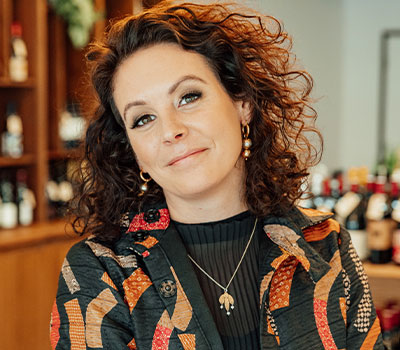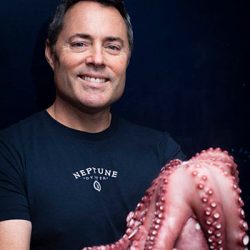Nicole Dougherty brings a fresh perspective to our poll report, speaking of the list at Tabula Rasa, a place that’s left-of-center of most restaurants we survey. With her focus on low-intervention wines from around the world, Dougherty commented that she had to enter a lot of her wines by hand into her poll response—wines that had not yet made it into our database from surveys in the past. —Patrick J. Comiskey


Thank you for broadening the reach!
Well, that’s sort of the state of things right now. The east side of LA by nature is a more progressive, cutting-edge area. I’m proud of our community, of our regulars who can be counted on to come in with an open mind. I was talking recently about what it was like when we opened in 2018 and where we’re at in 2023, what people were willing to taste then and what they’re willing to try now. What a world of difference! In ’18 we were coming up to guests and saying “Here, try this, this is an orange wine.” Or, “Try this pét-nat…” That feels like a hundred years ago. Now in 2023 people come in and ask, “What do you have new that’s orange? What’s a pét-nat I haven’t tried?”
In addition to everyone who comes through the door asking for an orange wine or pét-nat, they want chilled reds—that’s been the big trend lately.
We’ve had numerous winemaker events and educational series, many industry nights, but also nights where we’re not so focused on industry. We wanted to be a place where you didn’t need to know all the grand crus of Burgundy to be in this circle. We had winemakers like Craig Hartmeyer (of Hartmeyer Wine Cellars in West Sacramento) come down all tatted-up, put a wine glass in front of you and break it all down. Wine was always meant to be approachable, engaging, not heady, not so far above the general public’s level of knowledge to where it became inaccessible.
People’s knowledge now is that much better, then…
Yes. It’s great to have people know about these tiny little wineries, not only what to expect in the glass but what happens in the vineyard, who made the wine and how they’re treating their staff. All of that’s become really important to us in choosing our wines. Now it’s important to know: Who picked these grapes? Did they make a living wage? Where did they work in the off months? Were they supported? What’s the culture like in the winery? Is it inclusive? Are they lifting each other up?
How do you root out details like this?
It leans toward word of mouth, from the winemakers, and trusting your reps and importers and distributors. If you’re working with smaller importers and distributors, then it’s easier. I’d love if more of that information was online, but it’s not. It’s not easy to get information for natural wines anyway. They’re so small-scale; they don’t have anyone dedicated to writing tech sheets. And the wines themselves change every year. If a winemaker decides to throw in a bunch of semillon into the mix one year, it’s going to mean a totally different wine. That’s the improvisational nature of natural wines; there’s so much variance.
What’s the next step?
At this point, Tabula Rasa Bar is getting people to want something they’ve never had before, to push some boundaries. Had your share of orange wines? Here’s an orange-wine vermouth. Here’s the sake. That journey is always interesting, and of course, they’ve never had it because only six bottles were made. We can make it fun and interactive; it’s an exercise in trust and in playfulness.
Zach [Negin] and I opened the shop in North Hollywood in late 2022. We’re seeing all these differences in that neighborhood, where folks haven’t been as exposed to natural wine. It reminds us of what the bar [in Thai Town] was in 2018, when no one wanted to venture into too-crazy territory. It was, “give me something I’ve never had before, different, but stay within comfort.”
LA is crazy for orange wines and Tabula Rasa has a huge selection. What makes them so popular?
For one thing, it looks different from what most people have been exposed to before, so you’re going to get a reaction. Then they see the color and get the texture. “This isn’t like sauvignon blanc”—they’re engaged right off the bat. It’s a good hook, an entry way. Plus, there’s something really cool about turning people on to a beverage that’s been made in a similar manner for hundreds of years all over the world. We’re bringing this to light in 2023, and it still feels traditional and timeless.
How do you distinguish them for your guests?
We always have at least one wine that the staff calls the gateway orange. It’s like an “Intro to Orange” orange wine, something that’s super clean, and approachable, fleshy and fruity. If someone’s on the fence, we’ll start them with a splash, and if they like it, we can graduate them toward something more serious or robust or wild. I do feel that our little pocket of natural-wine lovers on the east side are usually open to something wild, some tannic, long-maceration orange from the Republic of Georgia.
Your number-one seller was a carignan blend from the Languedoc.
By the glass, yes, Philippe Pibarot’s Cante Renard. Wine in general is becoming hard to get at a lower price point. We tend to use wines like those from the Languedoc, with a long rich winemaking history but whose prices aren’t inflated. That’s one reason to pour it, but also because it’s a really interesting wine, very distinctly from a place, with just a tinge of wildness…there’s definitely a bit of bottle variation to keep it interesting.
Your next wine was a blend from the Burgenland, Austria:
Yes, the Joiseph Piroska, a blend of blaufränkisch, pinot noir and what they used to call Zweigelt, but what we call rotburger now because the inventor of that grape, Zweigelt, turned out not to be such a good guy (Zweigelt was a committed National Socialist). Unlike the Languedoc wine, this has great clarity, no variation at all, just bright and delicious. I personally love and adore clean natural wines.
Then there are wines like those by winemaker Evan Lewandowski, whose own exuberant personality comes through. Full of energy, distinctively his, each unique, interesting, tattooed, juicy, colorful, i.e., the story of Evan.
The last time I came into the bar we had Château Simone. I was so happy that wine was on the list and glad you have a penchant for traditionalists as you do for the natties!
Well, the last thing we want to do at the bar is chase a trend or get complacent. I hope we’re always pushing boundaries; I like to think we do, with aperitifs, with vermouths, sakes, and we’ve always had pretty large non-alcoholic program. We want to be known as much for traditional wines like Château Simone as the others. As you know, the roots in natural wine date back centuries, and when we find someone who maintains the tradition, we’re really excited; it’s great to tell people why they’re important and why they’re still around. A wine doesn’t need bubbles or a cute label to be good.
Patrick J. Comiskey covers US wines for Wine & Spirits magazine, focusing on the Pacific Northwest, California’s Central Coast and New York’s Finger Lakes.
This is a W&S web exclusive. Get access to all of our feature stories by signing up today.


















